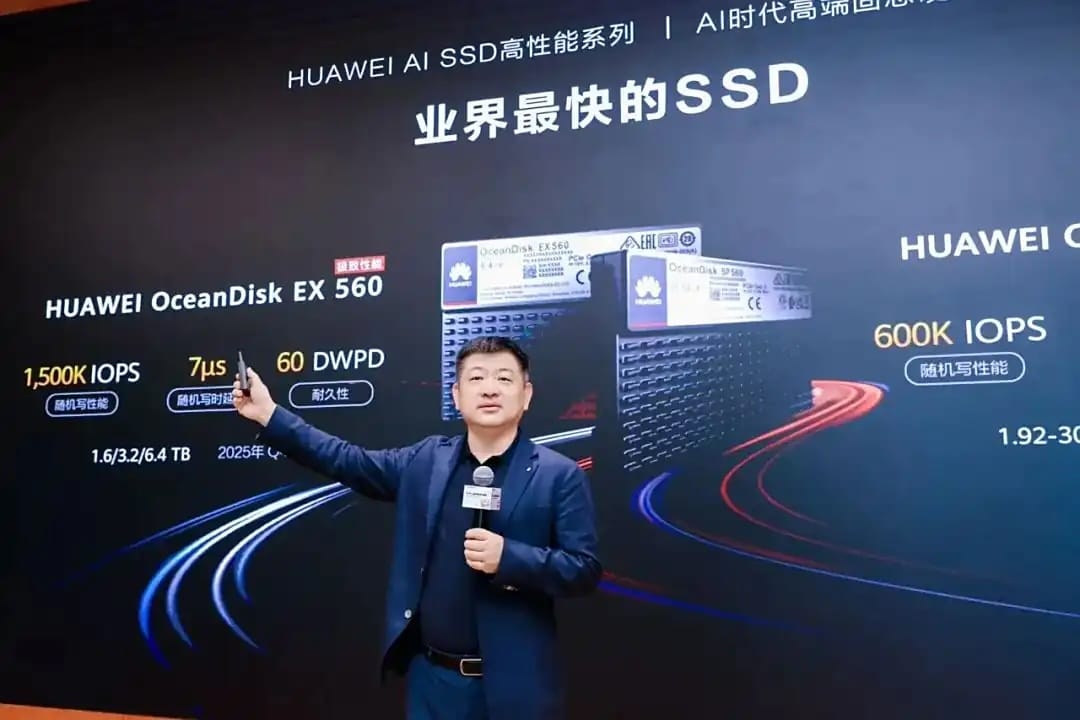Huawei has taken a strategic step in the global race for AI storage with the release of its OceanDisk SSDs, specifically designed for training and inference of large-scale models. The Chinese company aims to alleviate the so-called “VRAM wall” that limits AI growth, especially in a context marked by NVIDIA GPU shortages due to US trade restrictions.
Three models for different AI needs
Huawei introduced three variants within the OceanDisk 560 family, each tailored for a different scenario:
- OceanDisk EX 560 (extreme performance)
- Random write performance: up to 1.5 million IOPS.
- Latency: less than 7 µs.
- Durability: 60 DWPD (the drive can be rewritten fully up to 60 times per day).
- Maximum capacity: 6.4 TB, which equals 384 TB written per day.
- Focused on model training, it allows a sixfold increase in fine-tuning capacity per machine.
- OceanDisk SP 560 (smart performance / cost-efficiency)
- Performance up to 600,000 IOPS.
- Latency: less than 7 µs.
- Durability: 1 DWPD.
- Designed for AI inference: doubles inference sequence length, improves transactional performance by 1-2 times, and reduces 75% of the first token latency.
- OceanDisk LC 560 (large capacity)
- Maximum capacity: 245 TB, the largest SSD available on the market.
- Read speed: up to 14.7 GB/s.
- Designed for massive storage and multimodal data processing, key for training multimodal models and large-scale archiving.
DiskBooster: the virtual memory solution
Huawei also introduced DiskBooster, a virtual memory technology in a “pool” that combines different types of memory –HBM, DDR, and SSD– managed via software.
- Allows creating a pool up to 20 times larger than the native GPU memory.
- The goal is to leverage the speed of HBM, the abundance of DDR, and the capacity of SSD within a unified architecture.
- Also incorporates multi-stream intelligent technology to reduce overprovisioning effects and extend SSD lifespan.
A strategic move by Huawei
The OceanDisk launch addresses two fronts:
- Global market: competing with players like Micron or Kioxia in AI memory development.
- Technological independence in China: providing local alternatives amid the shortage of NVIDIA GPUs and limited access to HBM memory.
To strengthen this ecosystem, Huawei also announced the creation of a “AI SSD Innovation Alliance” with 11 industry partners.
A key move for data centers
The new OceanDisk models target data centers and AI companies seeking to balance cost and efficiency. With these SSDs, Huawei aims to:
- Reduce infrastructure costs compared to traditional solutions relying only on HBM.
- Maximize energy efficiency with memory optimized for specific AI workloads.
- Scale storage for models with trillions of parameters and multimodal corpora.
Conclusion
With OceanDisk EX, SP, and LC 560, Huawei marks a turning point in AI storage. From the most resilient SSD (60 DWPD), to the most cost-effective for inference, and the largest capacity in the world (245 TB), the company sends a clear message: it aims to lead the next decade of AI infrastructure, not only through networks and chips but also with optimized storage solutions.
Frequently Asked Questions (FAQ)
What does DWPD mean in an SSD?
It stands for Drive Writes Per Day. It indicates how many times you can fully rewrite the SSD each day during its lifespan.
What is the main novelty of OceanDisk LC 560?
Its capacity of 245 TB, the largest in the industry, makes it ideal for massive storage and multimodal training.
What is DiskBooster and why does it matter?
It is Huawei’s technology that combines HBM, DDR, and SSD into a unified virtual memory pool, allowing capacity to be expanded up to 20 times for AI workloads.
How does Huawei compare to Micron and Kioxia?
With OceanDisk, Huawei seeks to compete in the specialized AI memory segment, focusing on technological autonomy in China and filling the gap left by limited access to NVIDIA GPUs.
via: IThome

